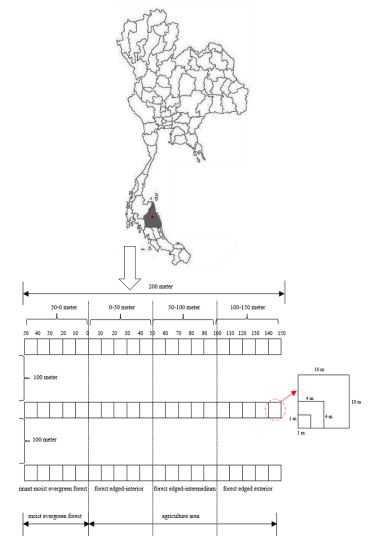Forest Structure and Species Composition Across the Forest Ecotone between Moist Evergreen Forest and Agriculture Area at Kathun Wildlife Sanctuary, Nakhon Si Thammarat Province
Keywords:
forest ecotone, moist evergreen forest, disturbance, plant diversity, natural forest restorationAbstract
Land use changes, particular conversion forest area into agricultural area induced the forest patches and led to plant diversity loss. This study aimed to compare forest structure and species composition across the forest ecotone between moist evergreen forest and agriculture area at Kathun Wildlife Sanctuary. Permanent transect plots, 10 m x 200 m, were established, and subplots of 10 x 10 m were divided. In addition, four zones related forest edged distance were classified based on the initiated area at the edge (0 m), moist evergreen remnant forest (RF), forest edged-interior (Ed-in), forest edged-intermedium (Ed-me), and forest edged-exterior (Ed-ex), respectively. All saplings and trees were tagged, measured, identified, and recorded position in the plot and saplings count the number of trees of each species. Ordination analysis was applied to detect the important factors for determining tree stands. The result showed the total of 82 species 68 genera and 41 families for saplings and trees were found. Tree density and basal area were 2,145 individual.ha-1 and 16.30 m2.ha-1, respectively. The dominance family based on highest number of species was Euphorbiaceae. The density of trees and saplings between zones were significantly different (F = 4.42, p ? 0.01 and F = 14.04, p ? 0.01, respectively). Highest density of tree was found in the RF and lowest in the Ed-ex, contrasting with the saplings. Tree diameter class distribution had the negative exponential growth form, indicating these areas can maintain their structure. However, different pattern, unimodal form, was detected for Payena acuminata, indicating discontinuous regeneration was found. The results of ordination found that high elevation and percentage of crown cover had determined tree species in RF. While high bulk density with low percentage of crown cover and soil moisture content had influenced on the establishment of pioneer species, particular at the Ed-ex zone. Indicating different tree species niche was detected. Thus, the suitable species related to its niche should be concern for forest restoration to promote forest recovery into the climax forest.
Downloads



.png)





